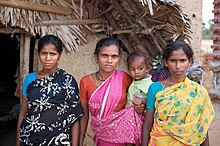
Dalit (English: /ˈdælɪt/ from Sanskrit: दलित meaning "broken/scattered") is a term used for untouchables and outcasts, who represented the lowest stratum of the castes in the Indian subcontinent.[1] They are also called Harijans.[2] Dalits were excluded from the fourfold varna of the caste hierarchy and were seen as forming a fifth varna, also known by the name of Panchama. Several scholars have drawn parallels between Dalits and the Burakumin of Japan,[3] the Baekjeong of Korea[4] and the peasant class of the medieval European feudal system.[5]
Dalits predominantly follow Hinduism with significant populations following Buddhism, Sikhism, Christianity, and Islam. The constitution of India includes Dalits as one of the Scheduled Castes; this gives Dalits the right to protection, positive discrimination (known as reservation in India), and official development resources.
- ^ "From Buddhist texts to East India Company to now, 'Dalit' has come a long way". The Times of India. 5 September 2018.
- ^ Santosh Bharatiya (2008). Dalit And Minority Empowerment. Rajkamal Prakashan Pvt. Limited. p. 230. ISBN 978-8126715992.
The clusters of epithet include Outcastes , Exterior - Castes , Depressed Classes , Untouchables , Ex - Untouchables , Harijans and Dalits.
- ^ Hankins, Joseph D (2014). Working Skin: Making Leather, Making a Multicultural Japan. University of California Press. p. 113. ISBN 9780520959163.
- ^ Sudrania, OP (9 September 2012). "Castes in a Global Perspective - Is Caste Only a Hindu Problem? (Part 6)". ChakraNews.com. Archived from the original on 5 May 2018. Retrieved 5 May 2018.
- ^ Noble, Thomas (2002). The Foundations of Western Civilization. Chantilly, VA: The Teaching Company. ISBN 978-1565856370.